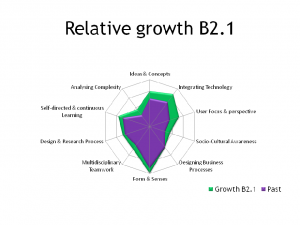Reflection per competency area
 On this page you can see an very rough overview of my competency growth based on the competency areas. This overview can be compared with the former Self Evaluation.
On this page you can see an very rough overview of my competency growth based on the competency areas. This overview can be compared with the former Self Evaluation.
1: Ideas & Concepts
During the project I became aware that designs focusing on a small improvement or assistance will lead to a major improvement of the whole problem due to it’s simplicity.
The assignment Aesthetic of a Design made me aware of the fact that a design should not be only functional. Also the aesthetic of a design is very important.
2: Integrating Technology
The assignments Gooey, Creative Programming for Designers and the Rhythm of Life project extended my computer programming and interactive prototype skills.
3: User Focus & Perspective
During the project I performed my first real professional user test in the hospital including 20 persons. The assignment Human Processes 1 enabled me to tune my designs to the cognitive abilities and limitations of the user. I acquired insight into models of human information processing, findings from experiments, and can apply this knowledge to solve concrete problems. I also got awareness on measuring the workload of the user. I can apply this knowledge in order to get a better understanding of the cognitive processes of the user while using a product.
4: Socio-Cultural Awareness
The Rhythm of Life 2.0 project made me aware of the fact that our design could save lives of premature babies. This made me aware that my role as industrial designer within the medical world can be important too.
5: Designing Business Processes
The extra curricular showed me a little awareness of the fact that within a company there are a lot of connections required in order introduce a product onto a market. I learned that business-managers become really enthusiastic when they have a concrete concept, including real numbers & facts and pre-done research. If I will elaborate with a company, I should protect myself with several law-suits and elaboration-agreements in order to prevent problems in the future. During expert-meetings with René de Torbal and René Janssen from Octrooicentrum Nederland I got basic instructions how to deal with this and how to search for existing patents of designs on specialized websites.
6: Form & Senses
During the project I increased my Rhinoceros and Illustrator skills. The assignment Creative Programming for Designers learned me how to create visualizations and animation by using the processing language. The assignment ‘Aesthetic of a Design’ made me aware of the different aspects of a form vocabulary within our social context and developed my aesthetic vocabulary. Furthermore I learned where to take care of while making a presentation/exposition aesthetically appealing.
A: Multidisciplinary Teamwork & Communication
The project made me aware that as designer I should be open for all kinds of input. I learned that I can learn from people who have other ways of thinking and rejudge my own ways of thinking. Furthermore I performed a small team a team-analyse in advance of the project which includes at least 3 mastering skills and 3 skills to development as concluded out of a personal questionnaire. This made the specialties of the teammates clear and contributed to a smooth team deviation. I will defiantly use this method again in the upcoming team projects. Furthermore The Aesthetics of a design assignment improved my presentation/exposition skills
B: Design & Research Processes
The main focus of the project was to do scientific research and perform a professional user test, which is comparable with the Design Against Fear Project. This resulted regrettably in relative short idea generation and selection phases, since a second year project is perfect to go deeper into the creative phases of the design process. Looking back it would have been better to perform the user test of Floris’ device earlier in the design cycle. In this way there was more time to perform a second user test in the Hospital in order to see whether our concept is better or not.
C: Self-directed & Continuous Learning
During this semester I tried to update my logbook weekly in order to support we while reflecting upon myself. This tool is very helpful and I will maintain it in the future. During the Rhythm of Life 2.0 project I addressed to perform reflection upon our project process and individual project goals every two weeks. This method supported us to keep on track of the design process and our personal development as well.
D: Analyzing Complexity
Concerning the project, the prototype we designed for user testing enabled us to collect vital data about the reanimation procedure. Cause of the huge amount of complex data it was impossible to perform calculations by ourself. I became aware that Mathlab is a powerful application to process and visualize data. However I learned how to process and visualize data in Microsoft Excel and how to do calculations with it. I calculated averages, standard-deviations and T-tests using Excel. Furthermore I visualized this data which made it useful to maintain overview of all the data. Also the use fixed values and standards (like pressure level and rhythm provided by the prescribed procedure) were useful to compare with the results of the user tests. Also during the Creative Programming for Designers assignment I learned how to perform data sorting and navigation by using processing language.